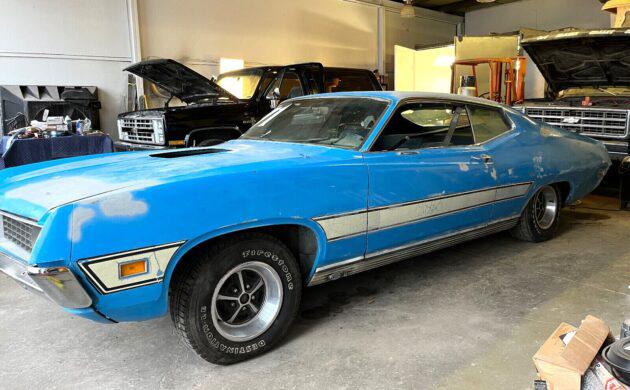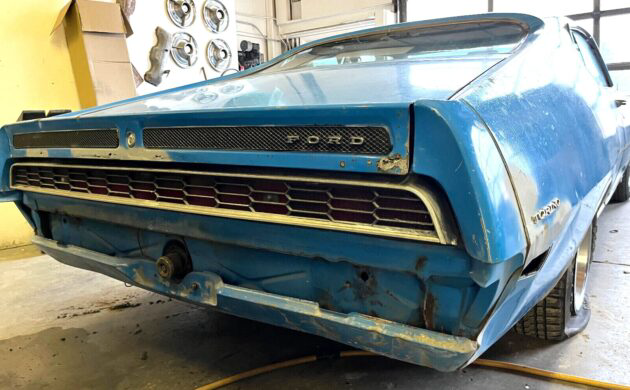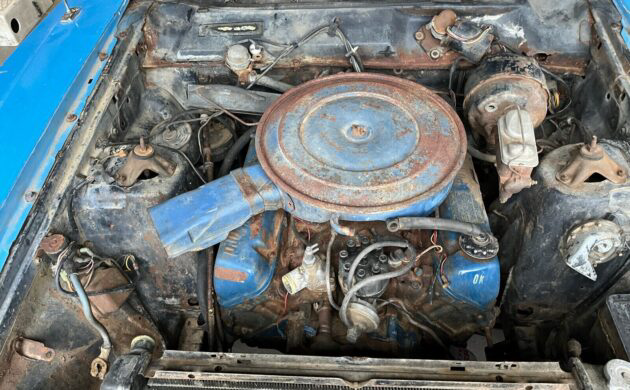Ford redesigned its mid-size cars in 1970, going for a more aerodynamic look. The slipperiest was the SportsRoof (Ford-speak for fastback) which could come in Torino 500, GT, or Cobra trim. The seller’s car is a GT that once had a J-Code 429 cubic inch V8 under the hood. Sadly, that firebreather has been replaced by what may be a 302 or 351. It’s had the same owner for 20 years and awaits a total restoration in Wahoo, Nebraska. This Grabber Blue Ford is available here on eBay where only a single bid of $5,000 has been cast, not enough to crack the reserve.
In the second year of the “aero look”, Ford built more than 31,600 GT fastbacks like the seller’s car. Yet the seller’s Marti Report places this Torino in rare company, being one of just 123 with the 429/C-6 automatic transmission. And just one of 33 finished in Grabber Blue with the associated trim level. Those are eye-opening figures, but since the original drivetrain is long gone and the original paint has worn out, they may not be as significant now. There’s a tag that includes factory air conditioning was onboard this Ford when new, but that hardware is no longer present.
Though the seller has had the car for two decades, we don’t know when it ran last. We’re told the engine isn’t locked up, so maybe it won’t take herculean efforts to get the Torino up and running again. The interior is probably going to need an extreme makeover, and it’s currently serving as a storage compartment for some of the stuff we assume comes with the deal.
The seller advises there is rust in the floors and quarter panels (aka “trunk sides”?). And there is a crinkle or two here and there, especially as it appears to the front and rear ends (the latter is missing its bumper). If you’re a fan of these cars and want to restore a muscle car that’s not a Chevelle SS 396, how about this one? And would you try to source a period-correct 429 with Ram Air?





Correct me if I’m wrong, isn’t the J-code the super cobra jet? I had a 70 Cobra J-code SCJ dragpack car. I would think this would be the same for 71 making this car pretty special and very rare.
No, J code is the standard CJ. Read the Marti report.
The rust I haven’t yet seen, scares me more that the rust in the eBay pics.
Well its not the original engine so its 1 of non n in my book
1 of 33 with this paint and trim code
1 of 123 with the 429/C6 combination.
Grabber blue
Good luck on sale
I great hot Rod car
I had a N code 429 vert hidden headlights model back in the day.
I still have the extra ram air breather in the garage that was in the trunk.
Both were he same etc
well in my eyes without the orig motor this is just a torino. with a dress on .. 😆
I have a 429 super cobra jet someone put it in a 59 Edsel ranger to build a drag car id let the whole car go for 10,000 the block is worth that
🤣🤣 No.
im not even mad at that, i dont mind edsels, hey ricky im on the way with the truck a chain, ill be there in 5 to get that edsel if ya dont mind steerin, i just picked up this 4 20 9 super cobra jet and were gonna stick it in there, thats how i imagine the conversation went, gotta 428 cj on the stand, almost got a 69 tornino that needed a fender, has a small block in it, last i checked its still sittin where it was 3 years ago
The original engine is gone, as mentioned in the seller’s description. The engine presently in the car is certainly a (non CJ) 429 or 460, not a 302 or 351.
$9000 BIN price, the current bid of $5100 would be the most I would go. I would put a 429 back in it, get it back to original. It would make a good resto mod
With the original engine gone, and a car in need of significant body work, including floor pan replacement and new metal for several panels, this one could burn a hole in your wallet quickly. Unless you can either source the original numbers matching engine and transmission, or want to build a restomod, this one is too far gone for both my taste and my wallet. The dead A/C system just adds to the pain, since to have any chance of restoring the A/C to working order, you’ll likely have to convert the system from R-12 to R-134a refrigerant, which just adds to the cost!
“Trunk sides” would be the sections of trunk floor that drop down and meet the lower edge of the quarter panel, and it is common to find rust there.
I’m sure this was once a very good looking car. So sad now.
I don’t know where you get that it’s a 302 or 351 engine. It’s definitely a 385 series, which means a 429 or 460.
I don’t know where you get that it’s a 302 or 351 engine. It’s definitely a 385 series, which means a 429 or 460.
Cool car, but this looks like a car that someone took all the “good” stuff off before selling it. The current seller probably intended to restore it but has realized it’s probably not worth it unless it’s your dream car. I think you’d have every penny it’s potentially worth into it when your done, but still have a non-original car. They seem to sell surprisingly low compared to a similar level of performance car by other makes, and I’m not even talking about Mopars.
One of my favorite big block, big cars. Also thought Grabber Blue was a great color and is why it’s on one of my race cars. Sad part here is the condition of the body. Not much car left and an expensive one to restore.
1 of 33 built like this in grabber blue. Never to be close to original again. For shame, for shame. 🙉
I think it was either 1973 or 1974 that I flew into Bluefield, W. Virginia for a job interview. I went up to the Hertz Rent A Center counter at the small airport and asked for a rental car for one day. I could hardly believe it when they told me they had a Torino available. So there I was with this beautiful red Torino which turned out to be really fast, especially since my car back home was a 1971 Pinto. So I have good memories about Torinos. But I would always run away from any vintage car with substantial rust.
the ’74 Torino was the third (3rd) generation Torino, with a full perimeter frame. The one for sale is a second-generation example, which, IMHO, is the best looking of the three (3) generations, but I like the body-on-frame construction of the last generation over the unibody cars of the first two (2) generations.
The first (1st) generation was from 1968-69, the second (2nd) generation was from 1970-71, and the third (3rd) generation was from 1972-76 (the Starsky & Hutch Era). Starting in 1977, the Torino was renamed the LTD II, but was essentially the same car under the skin. Source: Wikipedia.
https://en.wikipedia.org/wiki/Ford_Torino
Nice car. Sleek and not over the top. Better than a mustang of the same vintage in my book and much better that what they did to the Torino in the next few years.
That is a 385 series big block under the hood now, not a Windsor.
Looks like the rust bug found a home. Can’t figure out the shot on ebay with the hinge and loose wiring that is showing real rust.
Would be nice to see it in person but Nebraska visit isn’t in the cards for me.
Not worth much as it sits, current bidding at 5g+ seems over the top.
Stop removing my damn comments. I correctly called out the article writer for not even knowing the difference between a big block and a small block. Suck it up and admit your mistake, do NOT censor me for calling it out.
Auction has 10 minutes to go!
It’s worth the condition of the shell to me.
If it needs as much help as a tribute car to return to any former glory, then why not go restomod?
The value that vin holds for its next owner won’t go lower just because it sports a new 5.0 and modern brakes but the fun factor could be better than original.
I could see going either way, but if I were going the restomod approach and had the dough, I’d spring for a full aftermarket frame, and replace the live axle setup with a full IRS setup! One of my big pet peeves has always been that Detroit held onto the live axle rear end far too long. Granted, it was cheap to build and the tooling had been paid for for decades, but the competition from Europe and Asia had moved past the live axle at least twenty (20) years earlier, and Detroit’s perceived inferiority was costing them sales to the imported competition in the high end of the market. Ditto for the recirculating ball steering gear, a fine rack & pinion setup would be my preferred configuration. Most of the aftermarket frames are set up with rack & pinion anyway, only the IRS is an extra cost option.
I might consider keeping the “385” engine block, though, and dressing it up with a forged stroker crank, to bring the displacement out to 460 cubic inches, and bolting on an aftermarket top end, with new cylinder heads, a roller lifter cam, headers, and a new intake with port fuel injection and electronic ignition. One option would be to port and polish the stock heads in place of new heads, but add hardened valve guides and valve seats, so the original engine tolerates unleaded fuel better.
Guys like this are all talk, and don’t really know what they speak of. Bench racers, if you will. This car doesn’t have a frame, it is unibody. There are no aftermarket frames for these. You work with what it there or you do extensive fabrication and modification that destroys the soul of that car and takes away its unique character.
There isn’t a damn thing wrong with a solid axle, or recirculating ball steering on a car like this. Many REAL enthusiasts would absolutely love driving this car in stock form or with some light mods. If you want european design, buy european design, don’t take classic American muscle and try to make it more like something that is already readily available elsewhere in other forms. You miss the point of what these cars are all about.
A ‘real’ enthusiast
You always seem to have a big chip on your shoulder. What’s wrong with a guy dreaming about a car.
He’s absolutely right about american cars with regard to rack & pinion steering & independent rear ends. Americans are cheap and manufacturers are even cheaper.
As well, unit body construction did use welded in frames front and rear subframes with many of these old bodies being upgraded with r&p steering and later model independent rears.
It just sounds so petty for you to be the voice of ‘reality’ off someone else’s ramblings.
an enthusiast: 2 HUGE thumbs up!
And that’s what separates the non-enthusiasts from the REAL enthusiasts. I appreciate the character, soul and history of classic American cars the way they were built. I will make modifications to the cars I build, but they always remain true to the original form. If you’re not doing it that way then yes, you miss the point. Different strokes for different folks? Sure, absolutely. But I’m absolutely entitled to my opinion that you are wrong for wanting to turn an old American car into something it’s not. I’m not out here writing laws telling you what you can and can’t do, yet that’s how so many of you react when someone pushes back on your OPINION with their own OPINION. Too bad, deal with it. This culture that’s been created in America today where everyone is just supposed to agree all the time and never argue or debate is childish, stupid and totally unrealistic. Time to grow up and learn to handle disagreement.
a ‘real’ enthusiast
Nobody wants to deny your opinion. You just sound petty jumping on someone else’s opinion as though yours is better or the true way.
You may not want to be dissing the other guy but it sure sounds like you are.
So I’m suggesting you get a grip, get over your self righteous need.
‘Deal with it.’
Ended at $5,600, Reserve Not Met.
I’m fully aware that the Second Generation Torino was a unibody car. I didn’t say it would be easy, or cheap to add a full frame to the car, just that it could be done, and has been done in the past. Ford apparently agreed with me, at least in part, because they put a full perimeter frame under the Third Generation Torino, with trailing arms, coil springs and a Watt’s Likage, just like the T-Bird, which was as close as you could get to a fully independent rear suspension without losing the live axle. The Aussies apparently agreed as well, because they put a fully independent rear suspension under the Holden Commodore, which became both the Pontiac G8 and the Chevy SS, although both of those cars were unibody cars. If you don’t agree, that’s O.K., “A REAL Enthusiast”, to each his own, you’re entitled to your opinion, but there’s no need to get testy.
Aftermarket frames to fit most American iron are available from the Roadster Shop, Art Morrison Enterprises and Schwartz Performance, to name three (3) sources, here are some links:
https://artmorrison.com/
https://roadstershop.com/
https://www.schwartzperformance.com/
Both Dave Kindig and Chip Foose have used Roadster Shop frames on some of their builds, so if it’s good enough for them, it’s good enough for me! Now if I can just find the money to make it happen, I’ll be all set! Now where did I put that lottery ticket?